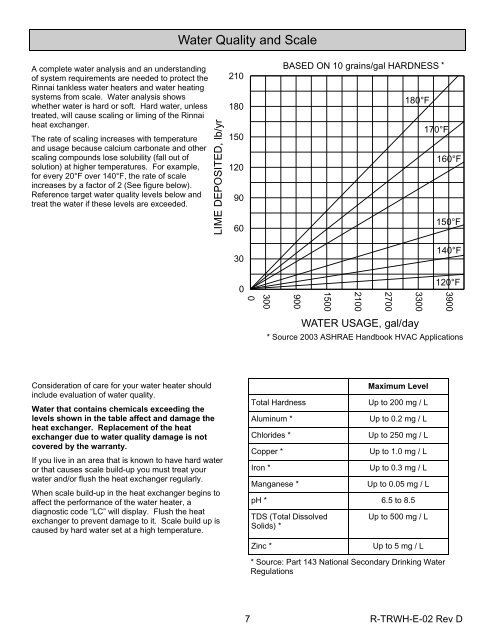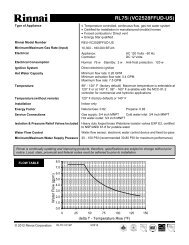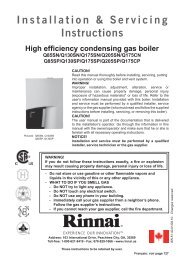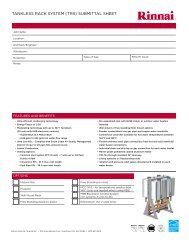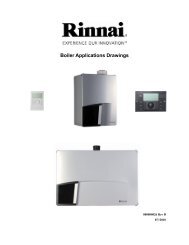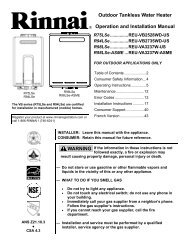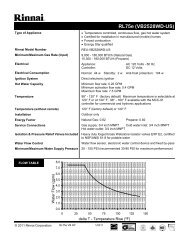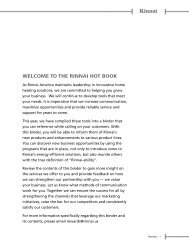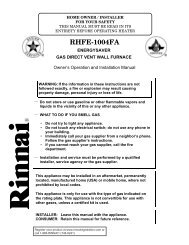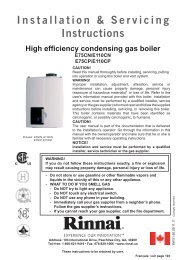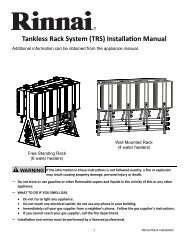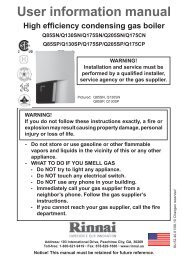Hot Water Design Manual Rev D - Rinnai
Hot Water Design Manual Rev D - Rinnai
Hot Water Design Manual Rev D - Rinnai
You also want an ePaper? Increase the reach of your titles
YUMPU automatically turns print PDFs into web optimized ePapers that Google loves.
<strong>Water</strong> Quality and ScaleA complete water analysis and an understandingof system requirements are needed to protect the<strong>Rinnai</strong> tankless water heaters and water heatingsystems from scale. <strong>Water</strong> analysis showswhether water is hard or soft. Hard water, unlesstreated, will cause scaling or liming of the <strong>Rinnai</strong>heat exchanger.The rate of scaling increases with temperatureand usage because calcium carbonate and otherscaling compounds lose solubility (fall out ofsolution) at higher temperatures. For example,for every 20°F over 140°F, the rate of scaleincreases by a factor of 2 (See figure below).Reference target water quality levels below andtreat the water if these levels are exceeded.LIME DEPOSITED, lb/yr210180150120906030BASED ON 10 grains/gal HARDNESS *180°F170°F160°F150°F140°F003009001500210027003300120°F3900WATER USAGE, gal/day* Source 2003 ASHRAE Handbook HVAC ApplicationsConsideration of care for your water heater shouldinclude evaluation of water quality.<strong>Water</strong> that contains chemicals exceeding thelevels shown in the table affect and damage theheat exchanger. Replacement of the heatexchanger due to water quality damage is notcovered by the warranty.If you live in an area that is known to have hard wateror that causes scale build-up you must treat yourwater and/or flush the heat exchanger regularly.When scale build-up in the heat exchanger begins toaffect the performance of the water heater, adiagnostic code “LC” will display. Flush the heatexchanger to prevent damage to it. Scale build up iscaused by hard water set at a high temperature.Total HardnessAluminum *Chlorides *Copper *Iron *Manganese *Maximum LevelUp to 200 mg / LUp to 0.2 mg / LUp to 250 mg / LUp to 1.0 mg / LUp to 0.3 mg / LUp to 0.05 mg / LpH * 6.5 to 8.5TDS (Total DissolvedSolids) *Up to 500 mg / LZinc *Up to 5 mg / L* Source: Part 143 National Secondary Drinking <strong>Water</strong>Regulations7 R-TRWH-E-02 <strong>Rev</strong> D


